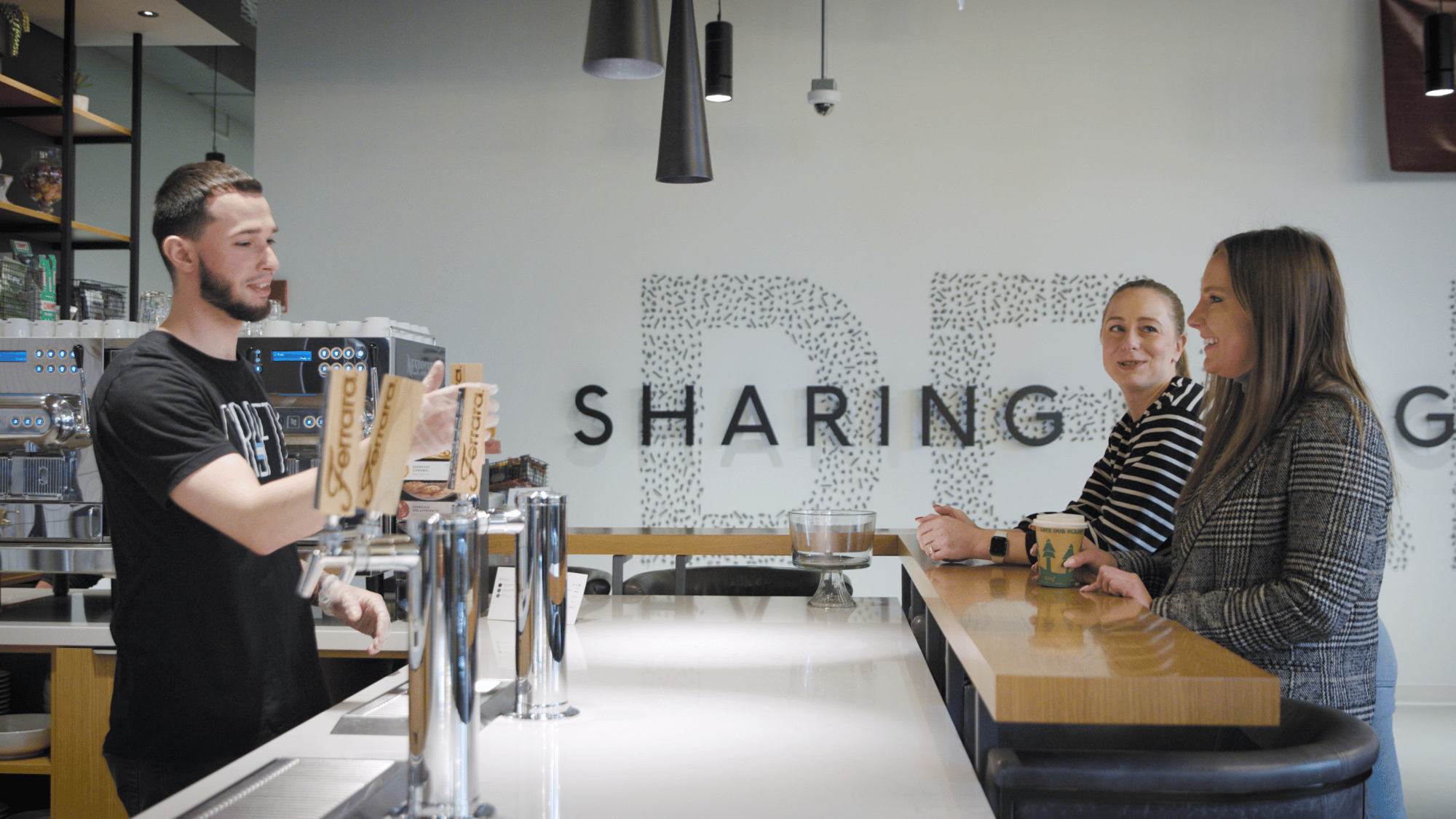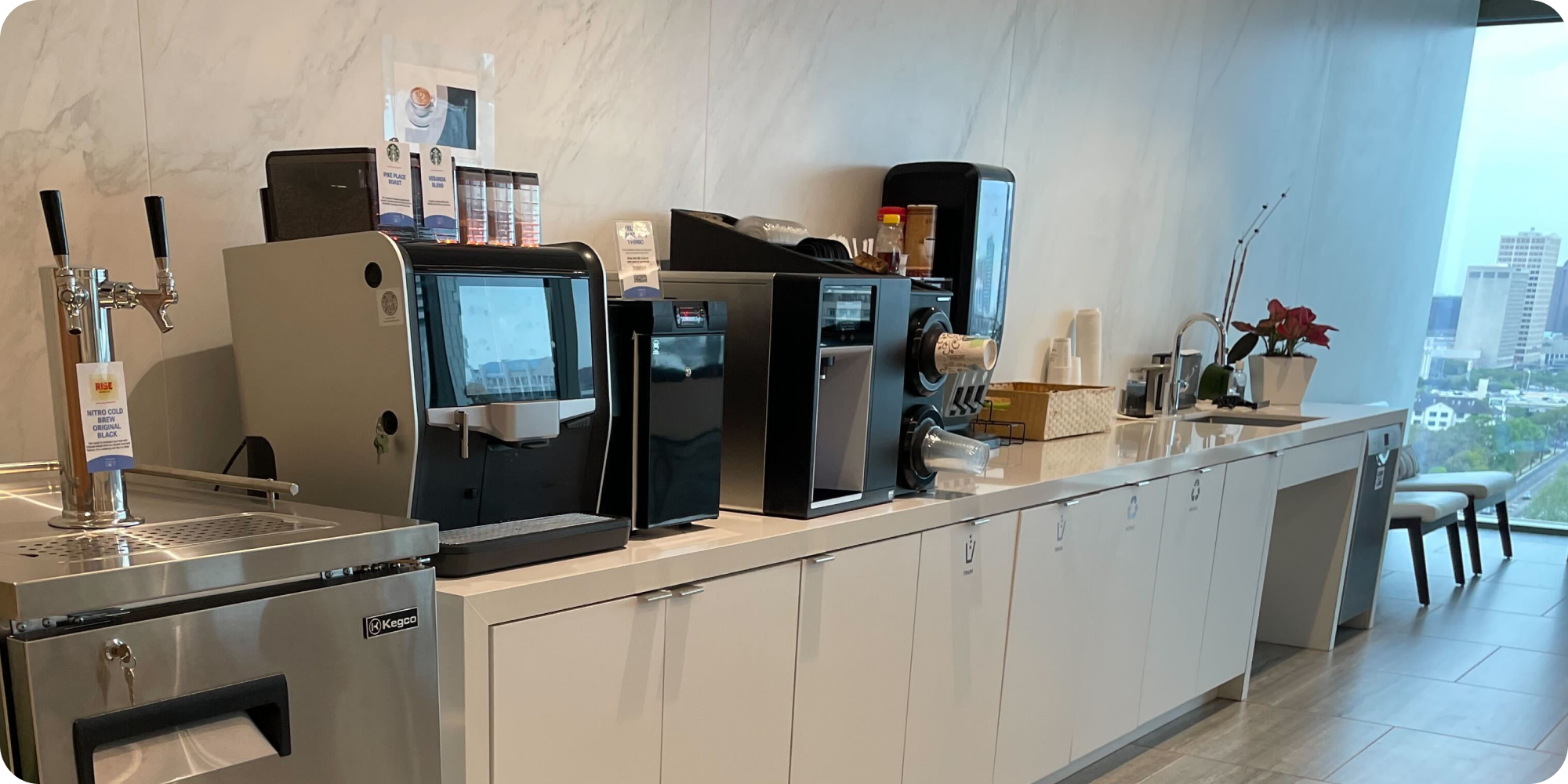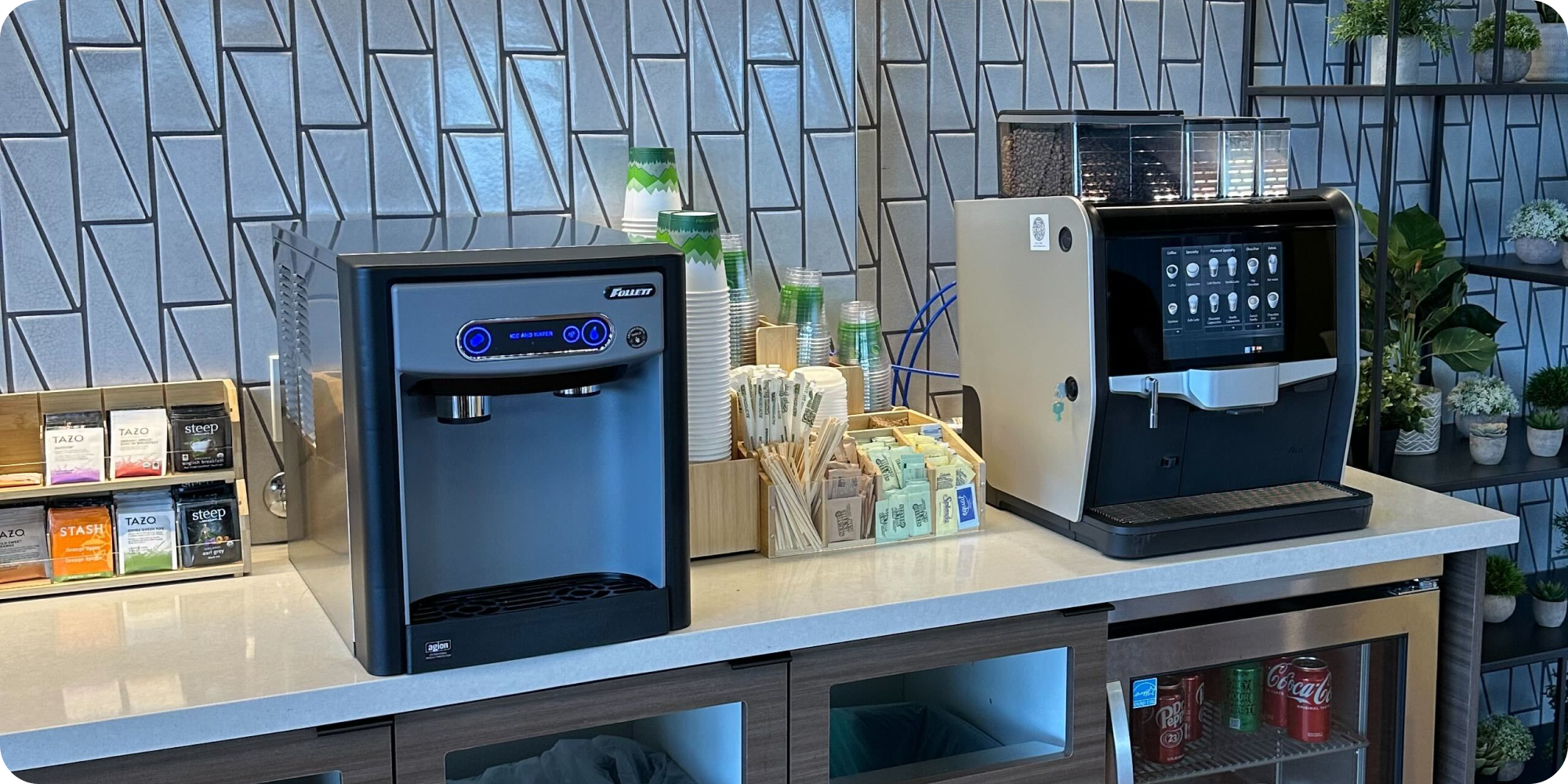Office Cold Brew 101: The Complete Guide to Cold Brew Coffee on Tap
Everything you need to know to bring cold brew on tap to your workplace.
✍️ Written by Rebecca Ross
🕚 15-Minute Read • Updated Monday, July 14, 2025

Perks aren’t just about ping pong tables and branded hoodies anymore; they’re part of how employees evaluate where they want to work and why they want to stay. And when done right, even something as simple as the coffee you offer can function like an added layer of compensation. But that only works if you’re offering what people want.
Employees are spending more on coffee than ever before. On average, they put $30.31 a month toward their caffeine routine. Six in ten Americans are opting for specialty drinks over standard brews, and cold brew is one of the most popular choices, costing around $5.14 per cup.
That makes cold brew an easy, high-impact opportunity for workplaces to upgrade their office coffee service, delivering real value without overhauling the entire program. So pour yourself a cup of coffee, and let’s tap into everything you need to know about cold brew in the office.
Table of Contents:
- What is cold brew?
- Why is it important to have at the office?
- Does cold brew have more caffeine?
- What are the different types of cold brew?
- What’s the difference between cold brew and iced coffee?
- What’s the difference between regular and nitro cold brew?
- How do I make cold brew at work?
- How much cold brew can be served in a keg?
- How long does a cold brew keg last?
- How do I tap and untap a cold brew keg?
- What if the keg isn’t pouring properly?
- How do you clean a cold brew keg?
- What’s the best cold brew for the office?
- Is cold brew coffee at work more sustainable?
What is cold brew?
Cold brew is coffee made by steeping coarse-ground beans in cold water for 12 to 24 hours. Because it’s brewed without heat, it extracts fewer bitter compounds and less acidity, giving it a smoother, naturally sweeter flavor that’s easy on the palate.
The result is a bold, refreshing coffee concentrate that can be served over ice, mixed with milk, or even infused with nitrogen for a creamy, tap-worthy finish.
Why is it important to have cold brew at the office?
Cold brew is more than just a caffeine fix. It’s a signal that your workplace is evolving with modern employee expectations. The cold brew market has experienced explosive growth from a niche offering in coffee shops to a mainstream must-have.
In fact, across Crafty-powered pantries, cold brew spend grew 77% year-over-year and now makes up 24% of all coffee units delivered. Why? Offering cold brew at the office can:
- Improves cognitive performance: Caffeine enhances alertness, attention, and memory by blocking adenosine receptors in the brain, making cold brew an effective way to support sustained focus during the workday (NIH).
- Supports team connection and collaboration: Structured or informal coffee breaks foster stronger social networks, which directly correlate with increased productivity and workplace satisfaction (MIT/SSRN).
What's the difference between cold brew and iced coffee?
While they’re both served cold, cold brew and iced coffee are brewed very differently:
- Iced coffee is brewed hot, then cooled. It tends to have a lighter body and brighter flavor, with a bit more acidity, which is great for those who prefer a classic coffee taste.
- Cold brew is never heated. Instead, it’s steeped in cold water, resulting in a smoother, more concentrated flavor with lower acidity and a naturally sweet finish.
What are the different types of cold brew?
Cold brew starts with the same slow-steeped base, but the flavor, texture, and delivery vary depending on the type. Here’s a breakdown of the most common formats you’ll find in the workplace:
- Classic Cold Brew:
Served from: keg with CO₂
Smooth, bold, and slightly sweet, this is the most familiar form. It’s often lightly carbonated with CO₂, which helps preserve freshness and adds a subtle crispness. - Nitro Cold Brew
Served from: a keg with nitrogen
Infused with nitrogen gas, this version is rich and velvety with a creamy mouthfeel and cascading pour. The nitrogen gives it a naturally sweet finish. - Ready-to-Drink (RTD)
Served from: fridge—no keg or gas needed.
Pre-bottled or canned cold brew that’s already diluted and chilled. Flavors vary by brand, but they’re typically less bold and slightly more mellow than tap options.
What's the difference between regular and nitro cold brew?
Both regular and nitro cold brew start the same way, but the difference comes down to the gas used during infusion and how it changes the drinking experience.
- Regular cold brew is often infused with carbon dioxide (CO₂), which helps preserve freshness and gives the coffee a crisp, bright finish.
- Nitro cold brew is infused with nitrogen gas. Nitrogen creates tiny, stable microbubbles that give the coffee a velvety texture and a thick foam. This smooths out any sharpness in the brew and brings out a naturally sweet flavor, even without sugar or milk.
Learn more about the difference between regular and nitro cold brew >
Does cold brew have more caffeine?
Yes, cold brew typically contains more caffeine because it is brewed as a concentrate with a higher ratio of coffee to water, and each serving delivers a more potent dose of caffeine. It is also less acidic and easier on the stomach, so employees may consume more of it throughout the day.
Here’s what that translates to in the workplace:
- Improved alertness and reaction time: Caffeine blocks adenosine, the chemical responsible for signaling fatigue. This helps employees stay mentally sharp during long periods of focused work (NIH, 2014).
- Enhanced memory and cognitive performance: The same study has shown that caffeine supports short-term memory and focus, making it easier to stay on top of complex tasks.
- Positive impact on mood and motivation: Moderate caffeine intake can stimulate dopamine production, which supports a more engaged and motivated mindset.
Your office coffee program doesn’t just energize employees, it helps them think more clearly, work more efficiently, and feel better doing it.

How to make cold brew at work
There’s more than one way to bring cold brew into the office, and the best coffee station setup depends on your team’s habits, space, and budget. Here's how most workplaces start and scale.
- Ready-to-Drink (RTD): RTD is the easiest entry point. You stock your fridge with cans or bottles of cold brew, giving employees variety without investing in equipment. It’s a great way to test interest, introduce different brands and brew styles, and see what your team actually consumes. The trade-off? Single-serve formats can get expensive with high consumption, and they generate more packaging waste.
- Kegs: If cold brew is already a crowd favorite in your office, a keg setup makes sense. With one or two kegs on tap, you can offer regular cold brew, nitro, or even mix it up with a second tap for kombucha or iced tea. It’s more sustainable than RTD, more cost-effective at scale, and creates a polished experience that feels intentional.
- Hybrid: Kegs + RTD: Some offices offer both. Maybe you have nitro on tap and keep a few regular cold brew RTDs in the fridge for employees who prefer that version. This setup balances variety with efficiency, without overcommitting to less popular options.
How long does a cold brew keg last?
When refrigerated and sealed, a cold brew keg stays fresh for 2 to 3 weeks. But depending on how much your team loves it, it might not last that long.
To help estimate consumption, we used national trends:
- 66% of American adults drink coffee daily (NCA, 2025)
- Around 30% of those coffee drinkers prefer cold brew, based on recent category growth
- That means roughly 18–20% of your office may reach for cold brew daily
Here’s what that could look like:
|
Office Size |
Estimated Cold Brew Drinkers |
Daily Cold Brew Consumption |
Kegs Needed per Day |
|
50 people |
~9 |
216 oz |
~⅓ keg |
|
100 people |
~18 |
432 oz |
~⅔ keg |
|
250 people |
~45 |
1,080 oz |
~1.7 kegs |
|
500 people |
~90 |
2,160 oz |
~3.4 kegs |
How do I tap and untap a cold brew keg?
Swapping out a keg might sound intimidating, but it’s quick and straightforward. Whether you're wrapping up an empty or getting a fresh one flowing, here’s how to do both:
Untapping a Keg
- Shut off the gas at the tank’s shut-off valve.
- Disengage the coupler handle by pulling it out 45 degrees from horizontal.
- Twist the coupler counterclockwise (~190°) to unlock it from the keg valve.
- Lift the coupler off the keg and set it aside.
Tapping a New Keg
- Align the coupler with the keg valve tabs and twist clockwise until it locks.
- Engage the coupler handle by pulling it out and pushing it down into place.
- Connect the gas line—CO₂ for regular, nitrogen for nitro.
- Open the gas tank valve to pressurize.
- Pull the tap to pour a test stream, and you’re good to go.
Check out our how to tap and untap a keg guide with photos >
What if the keg isn’t pouring properly?
Cold brew not flowing? Foam taking over? Don’t panic! Most tap issues are easy to fix. Here are a few quick things to check:
- No flow? Make sure the gas tank valve is open and the coupler is fully engaged.
- Too much foam? The keg might be too warm, or the gas pressure could be too high.
- Off taste or inconsistency? You may need to clean the lines or swap out a nearly empty keg.
These are common hiccups, and most are easy to handle with a quick adjustment.
For a full list of fixes, check out Crafty's troubleshooting guide.
How do you clean a cold brew keg?
Keeping your cold brew system clean is essential for flavor, performance, and safety. Whether you’re managing it in-house or relying on an office coffee delivery vendor, here’s what a good cleaning routine looks like:
- Rinse the lines with water after every keg change to remove leftover coffee oils.
- Sanitize the system weekly using brewer-approved cleaning solutions that break down buildup and bacteria.
- Replace tap lines periodically, especially if you notice off-flavors, poor flow, or visible residue.
What's the best cold brew for the office?
The best cold brew is the one your team drinks—but we’ve got the data to show what consistently hits across Crafty-powered workplaces.
Cold Brew Kegs
- Wandering Bear Coffee Straight Black Cold Brew
- Big Shoulders Nitro Cold Brew
- Big Shoulders Regular Cold Brew
Ready-to-Drink (RTD)
- La Colombe Cold Brew Black
- La Colombe Draft Latte Variety Pack
- Rise Nitro Cold Brew Original Black
Is cold brew coffee at work more sustainable?
Cold brew served from a keg is one of the most sustainable beverage options you can offer in the office. By moving away from single-serve cans and bottles, you dramatically reduce packaging waste, delivery frequency, and overall environmental impact.
Just one standard 5-gallon keg replaces about 80 single-serve bottles or cans. Multiply that by your weekly consumption, and the savings add up fast. When paired with compostable cups or reusable drinkware, a cold brew program becomes even more eco-friendly.
It’s a simple shift that aligns with workplace sustainability goals while still delivering a high-quality, energizing experience for your team.
Conclusion
Today’s employees are thoughtful about where they work and what perks matter, and something as simple as offering cold brew can signal that your company pays attention to the details.
Whether you’re starting small with a few ready-to-drink options or investing in kegs, cold brew is an easy way to deliver a premium experience your team already values. It supports productivity, encourages in-person connection, and brings your coffee program in line with what people are drinking.
Explore the Craftyverse
CRAFT
A BETTER
WORKPLACE
Elevate your office food and beverage program with enhanced services managed in one innovative, centralized platform.


